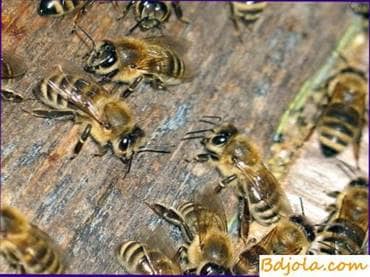The first inspection of a bee family in a greenhouse

After the purification flight, the bees proceed to clean the nest, begin to feed the uterus intensively, and the uterus – lay eggs. If the brood was seven before the introduction of the hive into the greenhouse, now its number is significantly increased.
On the 3-4th day after the introduction of the bee family into the greenhouse, inspect its nest. For convenience in work from the hive, remove frames that are not occupied by bees. They can be hung on a wire designed to tie twine with a lash of plants or put in a portable box. When inspecting the nest, the bottom of the hive is also cleaned at the same time. Clearing the first half of the hive from dead bees and wax litter, the bee’s nest is moved to a clean place. Looking at the nest, you first need to make sure that there is a uterus in the family and what is the quality of seeding.
The first frame with bees can not be watched, the uterus will not be there. In the absence of brood, the uterus should be sought in the center of the nest on a brown or dark honey-free honey. If the uterus could not be found, it is necessary to transfer the examination of this family to a later time, and to provide the family with a pearl. In no case should the control frame be given, since the sudden appearance of the brood in the nest, where the uterus has not yet begun laying eggs, is a phenomenon for bees. Bees can destroy the qualitative uterus and only later “come to your senses” and lay the fistulous queen cells.
Sometimes you can see on the honeycombs slightly expanded cells, especially in those places where they are shallow. This is a sign that even in the autumn there was no uterus in the family, and bees, because of the lack of young bee larvae, did not have the opportunity to withdraw the uterus and remained bezmatochnymi. With the confidence of the beekeeper that the frame with uterine bowls did not enter the nest
In well-to-do families, after cleaning the bottom of the hive, a nest is completed. To do this, in the middle of the nest put honeycomb with brood, as well as brown honeycombs with free cells for seeding. If the uterus is laid eggs in a dark, liable to be culled, and the larvae are not yet, then the honeycomb should be removed.
Honey combs with perga are placed near brood. In order for the brood to be larger, the pearls should be on both sides of the nest. If the frame with a pearl is dark and is to be culled, then it is separated from the brood by a continuous honey or light honeycomb. In this case, the uterus in the old hundred eggs will not be postponed and after use by the bees of the pergh it is removed. From the edge of the nest put light, heavy honeycomb, and also subject to culling.
Weak families, if possible, reduce their nests, and the distance between the streets is reduced to 8.5 mm. Therefore, when distributing pergamous frames, weak families need to give 1-2 frames with a greater prague content, and strong – a few frames with a smaller amount of penga, given that excess nest expansion will not affect them negatively.
Although it is always warm in the greenhouses, it is not necessary to refuse the upper cushion for the frames. It helps maintain a more even temperature in the nest with the lowest energy expenditure of bees. In spring and summer, the cushion protects the nest from overheating. However, lateral warming, even in weak families, is not necessary, as it serves as a refuge for moth larvae.
Lower leaves in greenhouse hives are partially opened, and the upper one is completely open. Bees prefer to fly through the upper chute.
In the first time the presence of bees in greenhouses (January, February), despite the significant years of bees on flowers, they show little activity in the concentration of fodder reserves. Honey from the printed frames in the nest of the bee reluctantly transferred to the center of the nest and do not react at all to the honeycomb hung in the greenhouse. Taking this into consideration, one should not give any beverages to bees at this time.
The bees, who have passed the winter, and who are to bring up a shift, need to create the best conditions. To do this, the fossilized pergu is removed from the nest, and the top of the moldy perga is cut and removed. If you do not do it in time, then all of the pepper soon becomes unsuitable for the bees, as the mold penetrates into the cell very quickly.
It is important that bees feed on and nurture brood on natural honey. Let honey be “sugar” as a last resort, but it is still better than syrup (the bees processed it and enriched it with enzymes, proteins). The recommendations of some beekeepers to induce bees to grow and actively visit flowers by feeding them flavored sugar syrup on a man’s flowers of cucumbers did not justify themselves. Old bees, who are left to live shortly, processing sugar syrup in honey, impoverish their body with protein. Such bees less educate brood, their life is shortened and it may happen that they will not wait for their change.
The first inspection of a bee family in a greenhouse
